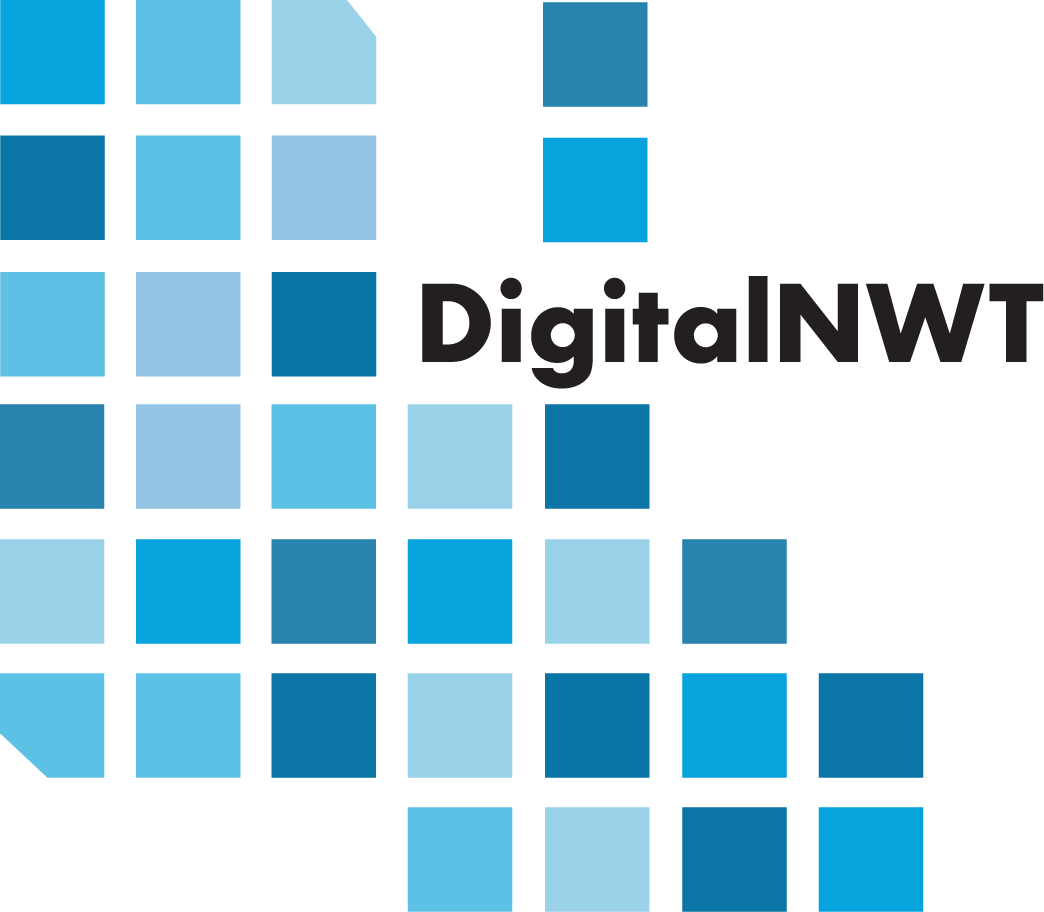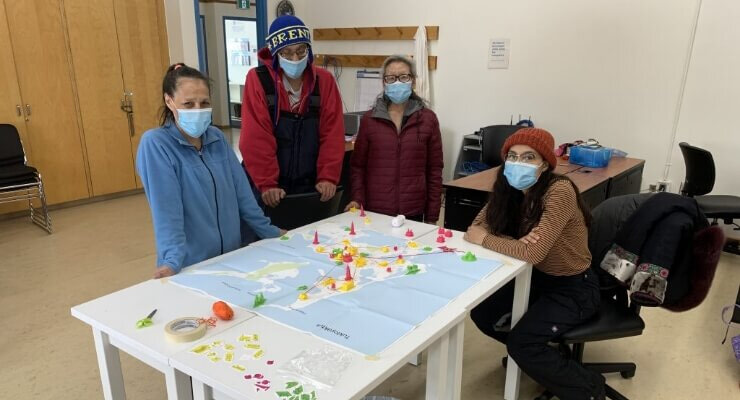Digital NWT supports digital literacy and Indigenous sovereignty in Northern communities
Published on MakeWay
With internet access becoming more ubiquitous and accessible, what does that mean for a community that hasn’t had digital literacy training, or where it isn’t widely accessible? DigitalNWT is answering these questions.
Digital NWT supports digital literacy and Indigenous sovereignty in Northern communities
Successful adult education in the Northwest Territories requires a deep and sincere understanding of the communities that you are working with. “If char is running in Ulukhaktok you don’t run classes. Teaching in that community for eight years, I learned that you need to consider fish migration, when the caribou are running, or as in Tsiigehtchic, when the break-up or freeze-up is happening. Things you wouldn’t think you needed to know as an instructor,” says Rebecca Dylanger, formerly a community adult educator at Aurora College Learning Center in Ulukhaktok, NWT, but now an educator in Tsiigehtchic, NWT.
That’s why when the team at DigitalNWT looked at developing a series of digital literacy courses to offer in the North, they knew that a train-the-trainer approach was going to give them the greatest chance of success.
DigitalNWT is a co-designed project where the team works with Northern partners to create material through a critical lens that acknowledges the problems that increased use of online technologies can bring. Collaborating with those already working in the North was key, as was partnering with other organizations that are already embedded in those communities.
Project co-director Rob McMahon, an associate professor in Media and Technology Studies and Political Science, is based out of the University of Alberta, with his office located in Edmonton. “We are all participatory researchers here and were very conscious of the problems of generating this material in the south in our office in this urban setting and then parachuting it in,” he says, “We challenged our assumptions on what communities want in these courses.”
Delivering what communities need most
Surveys and interviews helped the DigitalNWT project team understand what was important to Northern communities, what their fears, concerns, and hopes were when it comes to digital technology and the type of content that they wanted to learn.
Kyle Napier, communications coordinator for DigitalNWT is Dene/nêhiyaw Métis from Tthebacha, Denendeh, and says that he could only commit to this project secure in the knowledge that it was committing to ensuring the integrity of Indigenous knowledges and respect for that.
“What I’m particularly interested in for both my own nation and as someone who has dedicated himself to Indigenous language revitalization, is that play between digital technology and Indigenous sovereignty, what happens when you digitize Indigenous knowledges and how can you treat them?” Napier says, “When you relate that to connectivity, there are some communities that might prefer to have their own community networks that are detached from the larger internet to have intranets, so what does that look like? Some communities are interested in what those networks would look like, and how they might be appropriate for each community in each region.”
Course materials reflect these needs, concentrating not only on how to use online tools but also how hardware and systems work, breaking everything down to core components such as what is a network, how to access settings on your devices to secure privacy. Course workshops and activities also include how to test Internet speeds and measure data usage to avoid overage fees and prepare and file consumer reports for problematic internet services.
“With internet access becoming more ubiquitous and accessible, what does that mean for a community that hasn’t had digital literacy training, or where it isn’t widely accessible?” asks Napier, who explains that the entire government of Nunavut was shut down for three months because there was a phishing scam and all it took was for one person to click the wrong thing, and anything that relied on digital connectivity for communication was shut down. “That’s the judiciary, medical health records, anything connected to the government could only be communicated by phone, voicemail, and fax. Which sets you back years. You can see why the internet is so important, but also community sovereignty needs to be considered in tandem.”
Again, collaboration with Northern communities is key to this project. The guiding steering committee for DigitalNWT includes the Gwich’in Tribal Council (GTC), the Inuvialuit Regional Corporation (IRC), the Sahtú Renewable Resources Board (SRRB), and the Tłı̨chǫ Government. “They hold the ultimate authority, and have an agreement with MakeWay to that effect,” McMahon says. To deliver the program, the project partners with the Smart Communities Society (NWT), Hands On Media Education, and Aurora College.
There are monthly meetings between all these groups and sub-committees within the project. “It’s almost like a collective. There are a lot of groups involved but we try to keep it open, with everyone doing their own thing and then coming together to share ideas, suggestions and next steps,” McMahon says.
With so many moving parts, there are many operational requirements for DigitalNWT, and being part of the MakeWay shared platform has proved incredibly useful. “We’re working on this huge Excel sheet,” says DigitalNWT project manager Daniel Dokunmu who works out of an office in Inuvik, NWT, “Doing all that stuff through MakeWay makes those processes smoother and having dedicated project managers handle the reporting helps us keep track of everything. MakeWay makes dealing with the bureaucracy in government and with bigger institutions pretty easy.”
Disrupted by Covid-19
When DigitalNWT was established, research into access to the internet was always part of the mandate of the project, but when Covid-19 hit the research became a more pressing issue. “We started off doing these face-to-face classes and then we had to switch everything to online because of Covid-19,” explains McMahon. “We already knew of limitations with bandwidth and computers in the smaller rural communities, and then when we switched to doing everything online we very quickly found out how bad it really is.”
The project quickly trained up local researchers to go door-to-door information gathering and created an online #NWTDigitalDivide campaign encouraging those in Northern communities to share their internet challenges, and to take an internet upload and download speed test then screenshot and share results. “Some people in Ulukhaktok couldn’t even take the speed test, that’s how bad their internet is. Even the college employee in Ulukhaktok has to go home to attend video calls because the connectivity there is better than at work,” says Dokunmu.
The information gathered in this campaign was put into a report presented to consultations on Northern services held by the CRTC and generated significant media interest. The hope is that it will help fuel policy changes that will help promote more digital equity. “Historically Indigenous groups across Canada have secured funding to build their own community networks and internet infrastructures,” says McMahon, “In the past, there have been many other policy successes driven by Indigenous innovators and Indigenous internet service providers that have contributed to substantial developments.”
Developing and delivering course materials
In the first year of the project back in 2019, the DigitalNWT team developed the first set of course materials, which were then presented to adult educators from across the NWT during an in-person train-the-trainer session held in Inuvik. They told the group to rip it apart and tell them what was wrong, or missing. “We ended up redesigning everything. It’s amazing what you learn. Then we delivered the course in the communities and got more feedback from instructors and learners, then did the second version. We see it as this iterative process,” says Michael McNally, Associate Professor in the Faculty of Education at the University of Alberta.
This collaborative process has helped the project build trust in the communities that it works with, as has their work in raising awareness on access to the internet and the exorbitant fees that people in the North often have to pay for sub-par delivery of services. To address limited access to devices, Smart Communities Society, which administers the Computers for Schools program, provides learners with refurbished computers.
One challenge when it comes to designing a curriculum is that there is a range of existing levels of digital literacy in communities. “When we started piloting these workshops in Gwichʼin communities in 2017/2018, people were coming up to us to ask how to attach a photo to a text message to send somebody, so at a very beginner level. But then you also have visual artists, musicians, and other innovators who are already very skillfully using the internet as a tool,” McMahon says.
The flexibility of these courses has helped them be successful, says Dylanger. “The first course had enough to interest people that use a computer every day and still be relatable to Elders who have never used a computer,” she says. “These courses are different from any courses that we’ve delivered before. They are more hardware-based and getting more into the nitty-gritty and explaining how those things work, which helps you take more ownership, helping you know if you’re getting what you are promised and takes some of the mystery of the services that are provided.”
Feedback has been incredibly positive; there’s a thirst for this knowledge. “Our communities want the chance to learn about technology, especially now with Covid taking so much of life online,” Dylanger says. “Because the courses are now ours to use, they will be that part of our tool kit, for sure,” Dylanger says. Courses will continue to be offered free of charge to all participants.
Continuing the project
Federal government funding for the project is currently slated to end in March 2022 and Digital NWT is developing a transition plan that will enable free and open access to the courses that they’ve developed, which would continue to be taught by instructors trained through the project. “The plan was always to build the capacity in the North and leave it there, and in our last class, which is about building local networks, we are planning to provide a kit in a box that contains a server and a few wireless access points. We’d love to teach people in the last class to set it up and it gives them a way to access our curriculum on that server. That way people can take it and run with it,” explains McMahon.
That said, the DigitalNWT team would love to secure more funding and keep the project going. The project is receiving requests for course delivery in communities outside of the NWT, such as in Northern Alberta and the Yukon. Community residents have also shared some ideas for other courses. “There is demand for what we are delivering,” says Dokunmu.
DigitalNWT is one of 60 projects on MakeWay’s shared platform that benefit from being part of a mission-aligned community and having access to MakeWay’s expertise gained from decades of experience in the charitable sector and shared administrative resources. With MakeWay’s shared platform, changemakers share a suite of centralized organizational supports, and coaching when needed, so more time and money can go towards building strong, vibrant, just communities and a healthier planet.




